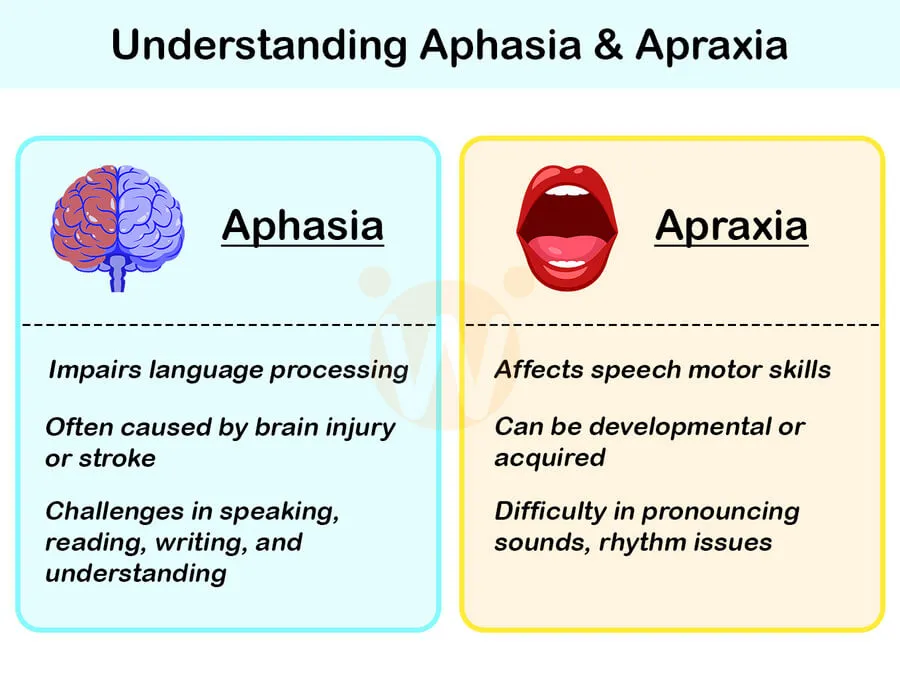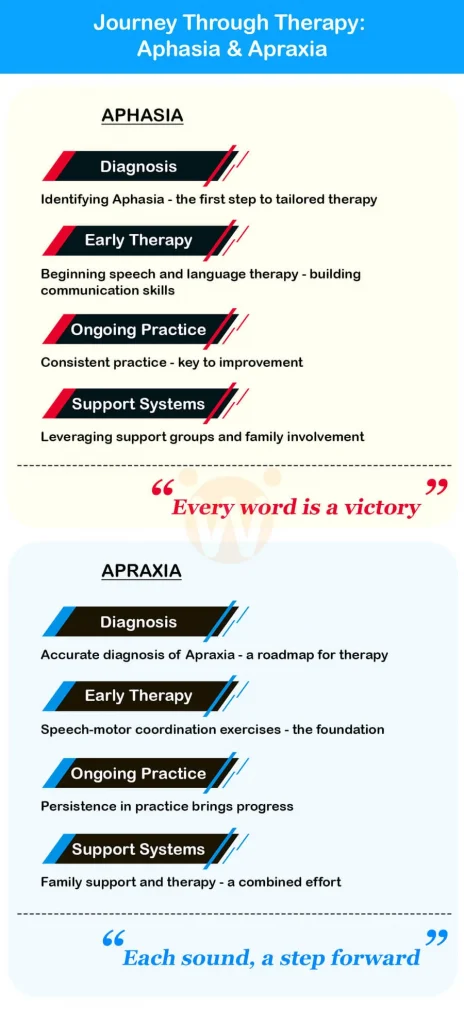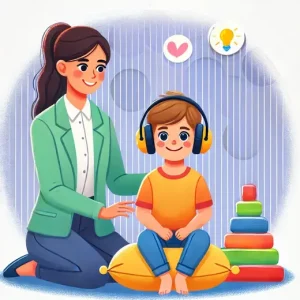Understand Aphasia and Apraxia: Improve Speech
By Rajini D
Last Updated: January 23, 2024
Language and speech are fundamental to our daily interactions and personal expression. They allow us to share our thoughts, convey our feelings, and connect with others. However, when disorders like Aphasia and Apraxia disrupt these abilities, the impact on an individual’s life can be profound.
Often, there’s a mix-up between Aphasia and Apraxia. Although they both affect communication, their causes, symptoms, and treatments differ significantly. Aphasia primarily impairs the ability to understand and produce language, whereas Apraxia affects the motor skills necessary for speech. Understanding these distinctions is crucial for proper diagnosis and effective management.
To understand the fundamentals of speech and language development, read more about it Speech and Language Milestones: 0 to 12 Months

Understanding Aphasia
Definition and Overview
Aphasia is like a roadblock in the world of language and communication. Imagine your brain knows what it wants to say, but the words just won’t come out right. That’s Aphasia for you. It’s a disorder that can affect your ability to speak, write, read, and understand language. It’s not about losing intelligence; it’s about losing the bridge that connects your thoughts to your words.
Causes of Aphasia
Most often, Aphasia is like an unwelcome guest following a stroke or brain injury. Imagine a storm (stroke or injury) hitting a city (your brain), and suddenly, the communication lines are down. That’s what happens in Aphasia. Other causes can include progressive neurological diseases like Alzheimer’s, which slowly dim the lights on language skills.
Learn more about conditions that can lead to Aphasia, such as stroke, in our detailed article Side-Effects of Coronavirus on the Mental health
Types of Aphasia
Aphasia comes in different shades. Broca’s Aphasia makes it tough to turn thoughts into words – like having the words on the tip of your tongue but not being able to say them. Wernicke’s Aphasia is the opposite – words flow, but they might not make sense, like a puzzle with mismatched pieces. Anomic Aphasia is the frustrating feeling of knowing what you want to say but just can’t find the words. And then there’s Global Aphasia, where both understanding and expression are severely impacted.
Also Read: Autism vs. Down Syndrome: Understanding the Differences
Symptoms of Aphasia
Symptoms of Aphasia can vary widely, but they all center around language difficulties. Some people might speak in short, incomplete sentences, while others might say sentences that don’t make sense. Reading, writing, and understanding speech can also be challenging. It’s like having all the letters of the alphabet but not knowing how to put them together to make words and sentences.
Recognize the signs of language disorders in our comprehensive guide Speech and language milestones – 5 to 6 years
Different Types of Aphasia: Characteristics and Impact
| Type of Aphasia | Speech Characteristics | Comprehension Abilities | Common Causes |
|---|---|---|---|
| Broca’s Aphasia | Non-fluent, effortful speech; short sentences with agrammatism. | Relatively good comprehension. | Stroke or damage to the frontal lobe of the brain, typically the left hemisphere. |
| Wernicke’s Aphasia | Fluent but often meaningless or nonsensical speech; word substitutions. | Poor comprehension, difficulty understanding spoken language. | Damage to the left temporal lobe, including Wernicke’s area. |
| Global Aphasia | Severe impairment in both expression and comprehension; very limited speech. | Severely reduced comprehension; may not understand simple instructions. | Extensive damage to the left hemisphere, often due to a large stroke. |
| Anomic Aphasia | Difficulty in finding the right words, especially nouns and verbs; speech is otherwise fluent and grammatically correct. | Good comprehension abilities. | Often associated with damage to the parietal lobe or temporal lobe of the brain. |
| Conduction Aphasia | Fluent speech but with frequent errors; difficulty repeating phrases. | Generally good comprehension. | Damage to the region between Broca’s and Wernicke’s areas, often involving the arcuate fasciculus |
Aphasia Treatment and Recovery
The road to recovery from Aphasia can be as unique as the individual. Speech and language therapy is the mainstay of treatment, where professionals help rebuild the lost bridges of communication. It’s not just about exercises; it’s about relearning and adapting. At Wellness Hub, we provide tailored support and resources to help individuals navigate their journey through Aphasia recovery. From personalized therapy plans to supportive community resources, we’re here to help every step of the way.

Exploring Apraxia of Speech
Definition and Overview
Imagine having all the words in your mind, but when you try to speak, they just don’t come out right. That’s Apraxia of Speech (AOS) for you. It’s not about the difficulty in thinking of words, but a challenge in coordinating the muscle movements needed to say those words. It’s like knowing the dance steps in your head, but your feet just won’t cooperate.
Also Read: Understanding Speech Delay: Causes, Milestones, and Therapy
Causes of Apraxia
Apraxia can sneak in due to various reasons. It might be because of damage to the parts of the brain that control speech – think of a skilled conductor suddenly unable to guide the orchestra. This damage can be due to a stroke, head injury, or other brain conditions. In some cases, especially in children, Apraxia might develop without a known cause, possibly linked to underlying neurological issues.
Types of Apraxia
There are two main types of Apraxia of Speech. Acquired AOS is like an unexpected detour in life’s journey, occurring in adults after they’ve already learned to speak. It usually follows a brain injury or stroke. On the other hand, Childhood Apraxia of Speech (CAS) is present from the start of the journey, affecting children from a young age, even as they’re just beginning to learn to speak.
Symptoms of Apraxia
The signs of Apraxia can be varied. People with Apraxia often have trouble pronouncing sounds, syllables, and words. It’s not due to muscle weakness but rather a coordination problem. They might make inconsistent errors in speech or have difficulty with the rhythm and flow of speech. Imagine trying to play a familiar song on a piano, but your hands can’t quite hit the right keys in the right order.
Apraxia Treatment and Management
For those navigating Apraxia, speech therapy is a beacon of hope. It’s a journey of retraining the brain to coordinate speech muscles effectively. Consistent practice, patience, and tailored strategies from speech-language pathologists are key. At Wellness Hub, we’re committed to providing support and resources for individuals with Apraxia, offering a path towards clearer communication and improved speech.
Aphasia vs. Apraxia – Key Differences
Understanding Aphasia and Apraxia can be simpler when we lay out their differences side by side:
| Aspect | Aphasia | Apraxia |
|---|---|---|
| Primary Impact | Language Processing (understanding and forming language) | Motor Planning (coordinating muscles for speech) |
| Key Symptoms | Difficulty with speaking, understanding, reading, and writing | Difficulty pronouncing sounds, inconsistent speech errors |
| Causes | Often due to stroke or brain injury | Typically, due to brain damage, it can be developmental in children |
| Treatment Focus | Language relearning and communication strategies | Speech-motor coordination and practice |
| Speech Characteristics | May use wrong words or incomplete sentences | Struggles with sound production, rhythm, and flow of speech |
Impact on Daily Life
Aphasia and Apraxia, while different, can both make everyday communication challenging. With Aphasia, imagine reading a book, but the words just don’t make sense, or trying to express a thought, but the right words evade you. Apraxia, on the other hand, is like knowing exactly what you want to say, but your mouth just won’t cooperate.
In daily life, this can mean struggles with social interactions, professional tasks, or even enjoying a simple conversation. These challenges can be frustrating and isolating, but understanding and support from others can make a significant difference.
Managing Both Conditions
Living with Aphasia or Apraxia is about finding new ways to connect and communicate. It involves patience, creativity, and, often, relearning skills. Speech therapy is crucial, providing tools and techniques to improve communication abilities.
Discover various speech therapy techniques and their effectiveness Unlocking Communication: Effective Speech Therapy for Autism.
Dispelling Misconceptions About Aphasia and Apraxia
Misconceptions about health conditions can create unnecessary hurdles in understanding and managing them effectively. In the case of Aphasia and Apraxia, clearing up these misconceptions is vital for providing the right support and treatment.
Also Read: What do Speech and Language therapists do?
Common Misconceptions about Aphasia
- Misconception 1: Aphasia is always associated with intellectual disability.
It’s important to know that Aphasia affects the ability to communicate, not intelligence. People with Aphasia retain their intellectual capabilities; they just struggle to express and understand language. - Misconception 2: Aphasia is a natural part of aging.
While the risk of conditions like stroke, which can lead to Aphasia, may increase with age, Aphasia is not a normal or inevitable part of aging. It’s a distinct medical condition that requires specific attention and care. - Misconception 3: Recovery from Aphasia is not possible.
There’s always a ray of hope. With appropriate therapy and support, many people with Aphasia can see significant improvements in their communication abilities. It’s a journey of patience and perseverance.
Common Misconceptions about Apraxia of Speech
- Misconception 1: Apraxia is just a severe form of stuttering.
Apraxia is not stuttering. It’s a motor speech disorder where the brain struggles to plan and coordinate the movements needed for speech. The challenges are different from those of stuttering. - Misconception 2: Children with Apraxia are just late talkers.
Apraxia in children is more than just a delay in normal speech development. It’s a specific condition where the brain has difficulty sending the right signals to create speech, necessitating specialized intervention. - Misconception 3: Apraxia can be outgrown without intervention.
Just like a plant needs water to grow, children with Apraxia need speech therapy to improve their speech skills. It’s not something they can simply outgrow; active and targeted intervention is crucial.
Addressing Misconceptions in Everyday Life
Educating others about Aphasia and Apraxia can start with simple conversations. Sharing accurate information helps build understanding and empathy. Supportive communities and resources, like those provided by Wellness Hub, play a key role in spreading awareness and offering accurate information. By fostering an environment of knowledge and support, we can make a real difference in the lives of those affected by these speech and language disorders.
Management Strategies for Aphasia and Apraxia
| Condition | Communication Strategies | Therapy Techniques | Supportive Tools/Resources |
|---|---|---|---|
| Aphasia | Use of simple, clear language, non-verbal cues, and patience in conversations. | Personalized speech and language therapy; group therapy for social communication; exercises to improve reading and writing skills. | Communication boards; speech-generating devices; mobile apps focused on language exercises; supportive online communities. |
| Apraxia | Breaking down words into smaller, more manageable parts; using gestures to support understanding; consistent practice in a comfortable setting. | Repetitive speech exercises to improve muscle coordination; melody-based therapy for rhythm; motor planning and sequencing exercises. | Apps for speech practice and motor planning; visual and auditory aids; specialized software for articulation practice; family and caregiver support resources. |
Conclusion
In our journey through “Decoding the Differences: Aphasia and Apraxia Unveiled,” we’ve navigated the complexities of these two distinct speech and language disorders. Aphasia, with its impact on language processing, and Apraxia, affecting motor speech production, each present unique challenges in communication.
We’ve seen how Aphasia can make speaking, reading, writing, and understanding a struggle, while Apraxia turns the act of saying words into a coordination challenge. Both conditions, however, do not reflect on an individual’s intelligence or worth.
Importantly, these conditions are not insurmountable. With a professional diagnosis, dedicated speech therapy, and ongoing support, many individuals make significant strides. The path to improvement with Aphasia and Apraxia is paved with patience, understanding, and the right guidance.
Remember, a professional diagnosis is key. If you or someone you know is showing symptoms of Aphasia or Apraxia, it’s crucial to seek professional advice. Early intervention can make a substantial difference in managing these conditions effectively.
At Wellness Hub, we are committed to providing support, resources, and a community for those navigating the challenges of Aphasia and Apraxia. Our goal is not just to inform but to empower, offering pathways to better communication and a higher quality of life.
Together, let’s embrace understanding, spread awareness, and foster a supportive environment for everyone affected by Aphasia and Apraxia.
For more resources and support on managing speech and language disorders, visit our comprehensive guide Alternative Solutions for Nonverbal Children
Frequently Asked Questions
1. What is the main difference between Aphasia and Apraxia?
Aphasia primarily affects language processing abilities, impacting speaking, reading, writing, and understanding. Apraxia, on the other hand, is a motor speech disorder where the challenge lies in coordinating the muscle movements necessary for speech.
2. Can children be affected by Aphasia or Apraxia?
Yes, children can be affected by Apraxia, known as Childhood Apraxia of Speech (CAS). Aphasia in children is less common but can occur, typically due to brain injury or a neurological condition.
3. Are Aphasia and Apraxia curable?
While there may not be a complete ‘cure,’ many individuals with Aphasia or Apraxia can improve significantly with appropriate therapy and support. Recovery depends on various factors, including the severity of the disorder and the type of intervention provided.
4. How important is early intervention in the treatment of Aphasia and Apraxia?
Early intervention is crucial in the treatment of both Aphasia and Apraxia. It can lead to more effective management of the conditions and significantly improve communication abilities.
5. Can Aphasia and Apraxia co-occur in the same individual?
Yes, it’s possible for an individual to have both Aphasia and Apraxia, especially if they have experienced a brain injury or stroke that affects multiple areas of the brain involved in language and speech.
6. What are the common causes of Aphasia?
The most common causes of Aphasia include stroke, traumatic brain injury, and neurodegenerative diseases. It is typically associated with damage to the language-processing areas of the brain.
7. What role does speech therapy play in managing Aphasia and Apraxia?
Speech therapy is a critical component in managing both Aphasia and Apraxia. It involves personalized strategies and exercises to improve language processing and speech coordination, enhancing communication abilities.
8. How can family and friends support someone with Aphasia or Apraxia?
Support from family and friends can be incredibly beneficial. This can include being patient in conversations, using clear and simple language, encouraging the use of therapy techniques at home, and providing emotional and practical support.
9. Are there technological aids available for individuals with Aphasia or Apraxia?
Yes, there are various technological aids and tools designed to assist individuals with Aphasia or Apraxia. These range from communication apps to speech-generating devices, which can greatly aid in everyday communication.
10. Where can I find more information and support for Aphasia and Apraxia?
For more information and support, visit Wellness Hub’s dedicated sections on Aphasia and Apraxia, where you can access resources, therapy options, and community support to navigate these conditions.
About the Author:
Anuradha Karanam
Speech-language pathologist (7+ years of experience)
Anuradha Karanam is a skilled speech-language pathologist with over 6 years of experience. Fluent in Tamil, Telugu, Hindi, and English, she specializes in parent counseling, speech sound disorders, fluency assessment, and speech-language evaluations. Anuradha excels at working with children with developmental disorders, offering creative and effective therapy programs. Currently, at Wellness Hub, she holds a BASLP degree and is registered with the RCI (CRR No A85500). Her patience, ambition, and dedication make her a trusted expert in her field.
Connect with Anuradha to learn more about how she can help you or your loved one find their voice.
Book your Free Consultation Today
Parent/Caregiver Info:
Client’s Details:
* Error Message









